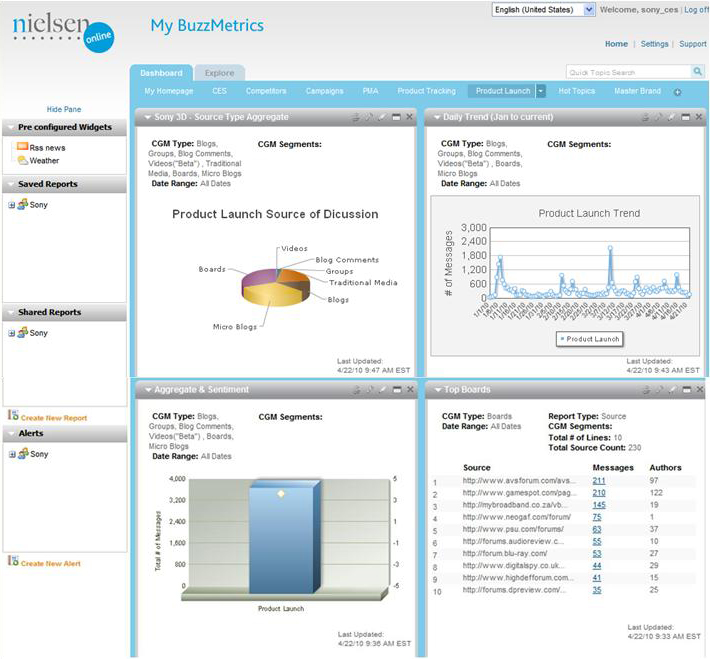Let’s say you’ve established a social media presence for your organization—a Facebook page, a Twitter account, a spot on YouTube, for instance—all that link back to your Web site.
You’re monitoring these platforms with free tools such as google.com/alerts, bloglines.com or search.twitter.com (to name a few); or you might be using paid monitoring tools like Radian6, Nielsen Buzzmetrics or Buzzlogic (also to name a few).
While you’re receiving metrics on key performance indicators like audience reach, activities and relevance, it’s reaching you from different platforms—disparate data that makes it difficult to get “the big picture.”
This scenario is played out in many organizations, says Mike Lewis, VP of marketing at Awareness Networks, a Waltham, Mass.-based social media marketing firm. “Not having immediate visibility into social media metrics is a problem we hear about with most of our clients,” he says. “The idea of having one dashboard that consolidates metrics becomes very critical for them.”
And critical for a variety of reasons:
• Visual Nature: Dashboards provide PR and other key business functions with an easy to see, and often flashy, view of activities. “That’s critical when your dashboard is being seen by busy C-level executives pressed for time, says Brett Safron, senior VP of global product management at Cision.
• Real-Time Capabilities: Aggregating metrics onto one platform in real time allows for getting the aforementioned big picture and the ability to make quick campaign decisions and adjustments, says Marcy Cohen, senior manager of communications at Sony Electronics. “This allows us to quickly go where are customers are going online,” she says.
• Value Add: “Dashboards today have the capability to integrate the various data streams, correlating monitoring with Web analytics or with business metrics such as profit margins, sales revenues, market share or revenue per employee,” says Katie Paine, CEO of KDPaine & Partners. “They’re what you look at to make sure you’re making a difference to the organization.”
 |
| A sample Sony Corporation product launch dashboard reveals (clockwise from top left) sources of discussion; launch trends; discussion board activity; and blog metrics. Source: Sony Corporation |
DASHBOARD CONFESSIONAL
Consensus has it that while creating a dashboard ranges from fairly simple to complex, it’s what happens before that creation that is often the most difficult step.
The most important aspect of a dashboard is to correctly pinpoint goals and key performance indicators that will be at its center, says Lewis. “We find that smaller companies often don’t take the time to map goals and key measurements, and larger organizations often spend way too much time trying to figure it out.”
Paine agrees that this critical first step to a dashboard is often botched. “Everyone underestimates how hard it is to get a consensus on what success means,” she says. “You absolutely need to be clear on the definitions of success from the top on down, so when the results come in, everyone agrees what ‘kicking butt’ means and what ‘it sucked’ means.” And, adds Paine, those definitions of success have to be relevant to C-suite executives, not just to the communications department.
A simple mantra in setting goals and metrics: “You should only measure things you’re willing to change,” says Paine.
CHOOSING THE DASHBOARD
Considering the large number of social media monitoring tools on the market, it’s not surprising that there’s a good many dashboard options as well.
Looking at dashboard possibilities per organization size, here are Paine’s suggestions:
• Small organizations: For those with little or no dollars to spend, PR pros can do-it-themselves using Google tools and an Excel spreadsheet. Paid dashboard services start in the $3,500 per year range.
• Midsize organizations: Best option might be in-house development with support from services like Radian6 or Nielsen.
• Large organizations: Those running multiple social media platforms on global scale might consider services such as SAS SMA, Cymfony and Affinity.
DASHBOARD DEFICIENCIES
Don’t think that having the visibility a dashboard provides will solve every measurement challenge, says Safron. “While dashboards provide a lot of aggregated quantitative data, more qualitative attributes need to be applied to determine real impact,” he says. His advice: Accept that there will be a manual aspect in crunching dashboard data.
Another caveat: Some organizations discover real difficulty in finding and then pulling social media data streams that really matter out of silos within the business. “It can be a very frustrating exercise,” says Paine.
THE FUTURE IS HERE
But for a big corporation like Sony, any dashboard drawbacks are outweighed by their capabilities—and possibilities.
An internal push is on at Sony to marry the social media dashboard with one that shows two key critical performance indicators: Net Promoter Score and Net Impact Score. “We’ve realized that to make those indicators accurate, we need to add social media’s impact to them,” says Christina Stahler, Sony’s senior manager of corporate research. (See a sample of a dashboard configured for Sony above.)
Such an integrated dashboard gives Sony’s marketing department and executive board more detailed views into the brand’s market penetration.
While Sony works internally on algorithms to make that integration happen, PR measurement firms are working on ways to show social media ROI via dashboards.
At Cision, says Safron, an effort is under way to incorporate a monetary value to social media metrics, similar to what is now done with traditional media.
“You’ll be able to set up your dashboard for any type of media and apply a common monetary figure,” he says.
For PR executives, that’s getting close to nirvana, because, as Safron says, “I don’t think the C-suite is close to moving past the monetary aspect of proving PR’s value.” PRN
CONTACT:
Mike Lewis, [email protected]; Bret Safron, [email protected]; Marcy Cohen, [email protected]> Katie Paine, [email protected]; Christina Stahler, [email protected].
